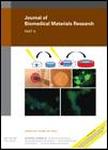版权所有:内蒙古大学图书馆 技术提供:维普资讯• 智图
内蒙古自治区呼和浩特市赛罕区大学西街235号 邮编: 010021

作者机构:Department of Orthopedic Surgery Faculty of Medicine Tokyo Medical and Dental University 1-5-45 Yushima Bunkyo-ku Tokyo 113-8549 Japan Institute of Biomaterials and Bioengineering Tokyo Medical and Dental University 2-3-1 Kanda-Surugadai Chiyoda-ku Tokyo 101-0062 Japan Department of Materials Science Graduate School of Engineering The University of Tokyo 7-3-1 Hongo Bunkyo-ku Tokyo 113-8656 Japan
出 版 物:《Journal of Biomedical Materials Research Part B: Applied Biomaterials》
年 卷 期:2000年第52卷第1期
学科分类:1001[医学-基础医学(可授医学、理学学位)] 10[医学]
主 题:adhesive bone cement 4-META TEM hybrid layer impregnation
摘 要:We have studied a new adhesive bone cement, that consists of 4-methacryloyloxyethyl trimellitate anhydride (4-META) and methylmethacrylate (MMA) as monomers, tri- n- butyl borane (TBB) as the initiator, and polymethylmethacrylate powder (4-META/MMA-TBB cement). This cement has shown remarkable adhesive properties to bone in vitro . In this study, we assessed the interface in vivo periodically. The femora of rabbits were fenestrated and filled with either the 4-META/MMA-TBB cement or a conventional polymethylmethacrylate cement. The animals were killed after 1, 4, 12, and 24 weeks to analyze the interface by optical microscopy and transmission electron microscopy. Optical microscopic examinations showed that the cured 4-META/MMA-TBB adhesive cement bonded to bone directly for 24 weeks, whereas a fibrous tissue layer was observed between the bone and cured conventional cement at 12 weeks after the operation. The transmission electron microscopy views of 4-META/MMA-TBB cement bonded to bone demonstrated a unique “hybridized bone with the cement in the subsurface of the substrate in every case. The formation of the hybridized bone indicates the bonding mechanism of the adhesive cement to bone, which prevents the fibrosis intervention between bone and cement. These results suggest that the biomechanical and adhesive properties of 4-META/MMA-TBB cement make it a useful bone-bonding agent in orthopedic surgery. © 2000 John Wiley & Sons, Inc. J Biomed Mater Res, 52, 24–29, 2000.